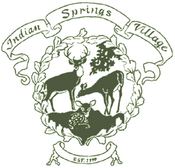Indian Springs Village: Difference between revisions
m (→History: Typo) |
No edit summary |
||
| Line 34: | Line 34: | ||
* [http://www.indianspringsvillage.org/ Indian Springs Village] website | * [http://www.indianspringsvillage.org/ Indian Springs Village] website | ||
[[Category: | [[Category:Indian Springs Village|*]] | ||
Revision as of 16:55, 24 April 2007
Indian Springs Village, also known as Indian Springs (incorporated in 1990) is a town located along Cahaba Valley Road near Bailey Gap at New Hope Mountain in Shelby County.
The Indian Springs Town Hall is a converted farm house. The current mayor, who is not compensated, is Steve Zerkis, whose term runs through 2008. The town council is made up of five places. The current councilors are Herb Robins, Brenda Bell-Guercio, Brian Stauss, Jack Mendel and Stewart Dudley. The town publishes a monthly newsletter, called The Village Voice.
Residents pay no property taxes, and the town's budget is drawn from annual fees and utility taxes. The town is part of the Shelby County School System, with grade schoolers entering through Oak Mountain Elementary School. The North Shelby Library and North Shelby Fire District No. 2 also serve the community. Heardmont Park is the nearest recreational facility, and Oak Mountain State Park lies just south of Indian Springs.
In May 1991, architect Christopher Faulkner presented the town with a proposed flag design. A logo contest resulted in a winning design by Julie Wyatt Schenk.
History
Indian Springs has been a recognized community for decades, with the first discussions of possible incorporation occuring as early as the mid 1970s when Jack Van Pelt helped secure a piped water supply from Pelham and organize the North Shelby Fire District. He was also active in the Indian Springs Civic Club that prepared a zoning plan for the area.
Indian Springs Village filed for incorporation on October 16, 1990 and its first mayor, Hub Harrington, and council were installed on February 12, 1991 at the Town Hall on the campus of Indian Springs School. The United States Postal Service recognized the new town as "Indian Springs", truncating the full name due to limitations of mail scanning technology.
In 2002, under its second mayor, Gene Weingarten, Indian Springs Village contracted with KPS Group to develop a comprehensive plan.
Events
Indian Springs Village sponsors an annual Fourth of July picnic and parade and an annual Easter egg hunt. The town has "adopted" the portion of State Highway 119 within its corporate limits and hold regular litter collection days. Indian Springs Village also celebrates "Founder's Day" each October.
Demographics
According to the 2000 census the population of the village, which covers 3.6 square miles, was 2,225. There were 789 households, and 685 families residing in the town. The population density was 610.5/mi². There were 809 housing units at an average density of 222.0/mi². The racial makeup of the town was 98.11% White, 0.09% Black or African American, 0.31% Native American, 0.90% Asian, 0.04% Pacific Islander, and 0.54% from two or more races. 0.13% of the population were Hispanic or Latino of any race. The town also claims a population of around 200 horses.
There were 789 households out of which 38.0% had children under the age of 18 living with them, 80.4% were married couples living together, 4.2% had a female householder with no husband present, and 13.1% were non-families. 11.9% of all households were made up of individuals and 4.6% had someone living alone who was 65 years of age or older. The average household size was 2.82 and the average family size was 3.05.
In the town the population was spread out with 25.7% under the age of 18, 5.3% from 18 to 24, 21.7% from 25 to 44, 34.7% from 45 to 64, and 12.7% who were 65 years of age or older. The median age was 44 years. For every 100 females there were 105.1 males. For every 100 females age 18 and over, there were 96.9 males.
The median income for a household in the town was $92,229, and the median income for a family was $96,760. Males had a median income of $66,648 versus $42,222 for females. The per capita income for the town was $37,904. About 0.1% of families and 0.4% of the population were below the poverty line, including none of those under age 18 and 0.4% of those age 65 or over.
References
- "Indian Springs Village, Alabama." Wikipedia, The Free Encyclopedia. 29 May 2006, 18:29 UTC. Wikimedia Foundation, Inc. 2 Sep 2006 [1].
External links
- Indian Springs Village website
